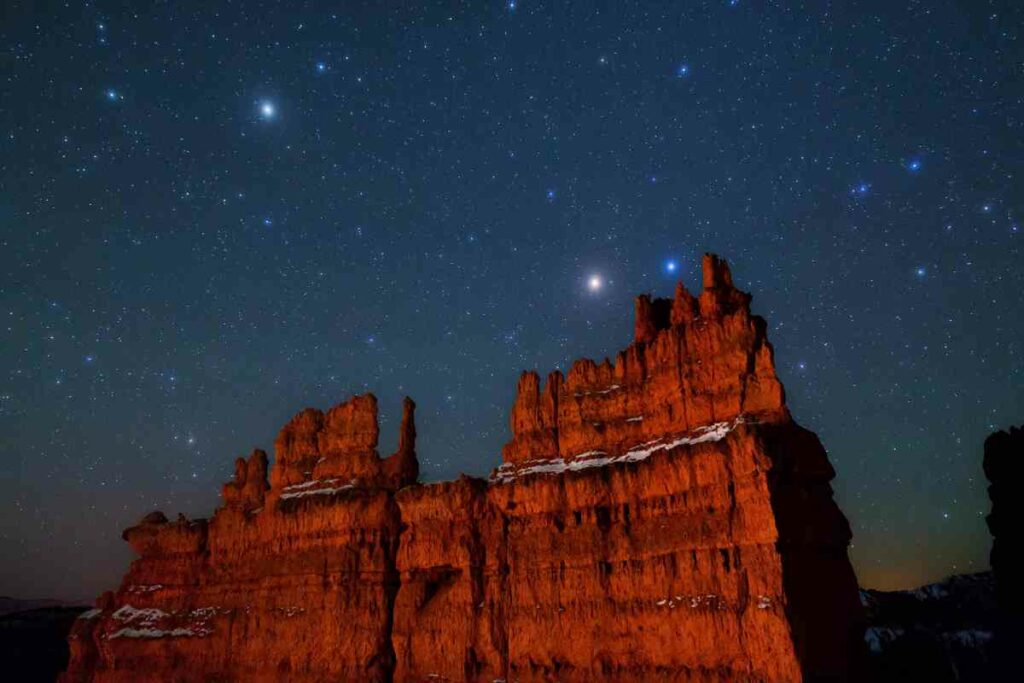There are countless stunning destinations around the world that offer unparalleled views of the night sky.
Whether you are into stargazing or an astrophotography enthusiast, here are the best 7 destinations for skywatching.
1. Mauna Kea, Hawaii
Mauna Kea on the Big Island of Hawaii is one of the world’s premier destinations for stargazing and astrophotography.
Located 13,800 feet (4,207 meters) above sea level, Mauna Kea stands as one of the highest points in Hawaii. Its high elevation creates an ideal vantage point for looking into the night sky.

With some of the darkest skies in all of the United States, Mauna Kea offers unparalleled views of:
- Stars
- Galaxies
- Other celestial bodies
It’s not just a great place to explore with your eyes either; its dark skies also make it perfect for capturing stunning images through astrophotography.
The observatory atop Mauna Kea houses 13 telescopes which makes it an essential destination for astronomy researchers and scientists.
You may also like ?
But even if you’re not an astronomer, you can still get a great view of the stars from Mauna Kea.
All that is required is a telescope or binoculars and some patience to be able to witness this beauty firsthand.
The best time to visit Mauna Kea, Hawaii is during the summer months of June through August. These are the warmest and driest months of the year, making it easier to explore the mountain, as well as its many attractions.
To protect the night skies from light pollution, there are certain restrictions in place as to what kind of lights people can use in the area.

Moreover, attention must also be given to environmental factors like air quality; due to its elevation, Mauna Kea has especially thin air which can create special challenges for astrophotography.
Despite these challenges, the rewards are worth it—Mauna Kea provides one of the most incredible views of our universe available anywhere on Earth.
2. Kerry International Dark Sky Reserve, Ireland
Kerry International Dark Sky Reserve in Ireland should not be overlooked when searching for the best places to stargaze and take astrophotography.

Southwest Ireland’s Blarney Nature Reserve covers an area of nearly 270 square miles (700 square kilometers).
It boasts one of Europe’s darkest night skies, perfect for:
- Star gazing
- Planets
- Comets
- Star clusters
In 2014, The Kerry International Dark Sky Reserve was officially recognized as such after its board of directors submitted an official declaration.
The board collaborated closely with local communities, organizations, and businesses to protect their dark skies from light pollution.
As part of this endeavor, innovative lighting strategies were implemented to reduce light pollution, allowing visitors to enjoy star-studded skies and an unforgettable view.
The Kerry International Dark Sky Reserve is home to some stunning sights, including the Milky Way, nebulae, and star clusters such as The Pleiades and The Hyades.
Kerry International Dark Sky Reserve in Ireland offers some of the best stargazing opportunities from April through September. At these times, skies are usually clear and provide some of the clearest skies in all of Europe.
Astrophotography enthusiasts will love the abundance of opportunities to capture stunning shots of celestial objects due to the reserve’s dark environment.
Visitors to the area can take advantage of many stargazing events organized by local astronomy clubs throughout the year.
3. The Atacama Desert, Chile
The Atacama Desert in Chile is renowned for its clear skies and excellent views of the night sky.
This desert, located between the Pacific Ocean and the Andes Mountains, is one of the driest places on Earth.

The lack of moisture makes it an ideal spot to observe stars and galaxies through telescopes or cameras with long exposure times.
Astronomers have even dubbed it “the most beautiful place in South America” due to its stunning views of planets, constellations, and other celestial bodies.
The Atacama Desert provides excellent opportunities for astrophotography due to its remoteness from light pollution.
Some amateur photographers have even captured award-winning images in this area! If you’re searching for some spectacular stargazing or astrophotography, the Atacama Desert should definitely be on your list of destinations.
The Atacama Desert in Chile is best enjoyed during its dry season, which runs between April and October. Temperatures here range from mild during the day (the high 70s-80s Fahrenheit) to cool evenings (low 40s Fahrenheit).
Due to its incredibly clear skies, this region has become a popular destination for professional astronomers who come here to conduct important research about our universe.
The abundance of stars and galaxies that can be observed in the area makes it an ideal spot for astronomical observations.
The Atacama Large Millimeter/submillimeter Array (ALMA) is located nearby and uses 66 antennas to observe the sky in unprecedented detail.
It was inaugurated in 2013 and is currently one of the largest observatories in the world.
4. River Murray, South Australia
South Australia’s River Murray is an oasis of tranquility, surrounded by towering gum trees, red river gums, and the occasional koala.
Not to mention some of the clearest night skies in Australia! Its location away from major cities makes it perfect for stargazing and astrophotography.

With a dark night sky as far as the eye can see, you will be able to witness awe-inspiring views of stars, planets, and galaxies that you won’t find anywhere else.
The Milky Way Galaxy shines brightly across the horizon from horizon to horizon—a sight so remarkable that it will make your heart skip a beat.
You can also catch glimpses of other celestial bodies such as:
- Comets
- Novas
- Meteor showers
The best time to visit River Murray, South Australia is during late spring or early summer. This is when the weather is typically mild and pleasant.
You may also like ?
If you’re feeling adventurous, take a camping trip and enjoy the view from the banks of River Murray—a great way to spend a weekend!
With its uninhabited shoreline and secluded beauty, it is no wonder that River Murray is one of Australia’s top spots for stargazing and astrophotography.
5. Pic du Midi, France
Pic du Midi, France is one of the best places in the world for stargazing and astrophotography.
Located in the French Pyrenees, it offers some of the clearest night skies over Europe.

At an altitude of 9,439 feet(2,877 meters) above sea level, this location provides incredible views of stars that are rarely seen from other locations on Earth.
The area also has no light pollution making it ideal for photographers who want to capture fantastic images of stars and galaxies.
The observatory at Pic du Midi houses multiple telescopes as well as a cafe and pleasant viewing deck where visitors can take in spectacular night skies.
It’s also home to some interesting events such as ‘astronomy nights’ where experts give lectures about the night sky and answers questions from visitors.
Pic du Midi is a unique spot for those interested in the stars and the perfect place to capture stunning photographs of our universe. The best time to visit Pic du Midi, France is during the summer months.
With its incredible views of the Milky Way, it is truly one of the best destinations for stargazing and astrophotography!
6. Mont-Megantic, Canada
Mont-Megantic in Canada is one of the best places for stargazing and astrophotography, and it’s also a great spot for camping.
The area is home to Mont Megantic National Park, which provides an ideal dark sky environment away from light pollution.

With its high altitude and clear skies, visitors can enjoy seeing sparkling stars above them while they camp under a blanket of surreal starlight.
The national park has an observatory that allows visitors to view distant galaxies through powerful telescopes.
This makes it a perfect destination for amateur astronomers as well as avid photographers looking to capture beautiful photos of the night sky.
For those who want to try their hand at astrophotography, there are plenty of opportunities here: the ASTROLab du Mont-Mégantic offers workshops and programs for aspiring astrophotographers as well as guides who can help with the technical aspects of taking amazing nighttime photos.
The best time to visit Mont-Megantic, Canada is during the summer months of June through August.
No matter what your experience or skill level, it’s easy to find a way to get the perfect shot in Mont Megantic National Park!
While camping beneath the stars is definitely one of the best things about visiting this area, it’s worth spending at least a day doing some exploring on foot during your stay.
7. Bryce Canyon National Park, Utah
Bryce Canyon National Park, Utah is a stargazer’s paradise.
Located in southern Utah, Bryce Canyon’s unique geological features and relative darkness make it an ideal spot for capturing the night sky.

With minimal light pollution and no nearby cities or large towns, you can find some of the darkest skies in the United States here.
On clear nights, you can expect to see stars, galaxies, nebulas, meteors, and more that are simply stunning to behold.
A good time to visit Bryce Canyon is during its annual Astronomy Festival – usually held in late April or May – when astrophotographers from all over gather to take photos of the Milky Way above and take workshops on photographing the night sky.
No matter your level of experience or proficiency with astrophotography, the Bryce Canyon Astronomy Festival is a must-attend event.
If you’d prefer to observe the night sky at Bryce Canyon on your own, sunset and sunrise are ideal times to witness some of nature’s most stunning light shows.
Be sure to bring plenty of warm clothing and beverages as temperatures can drop considerably at night!
No matter when or where you visit, don’t forget to bring your camera! Capture some unforgettable pictures of this breathtaking location!
With some luck, you might even spot some shooting stars during your stay!
Final Words
Pack your camera and camping gear and head over to one of the best destinations for stargazing and astrophotography. Experience the night skies and the unknown outer world by visiting one of these destinations.









